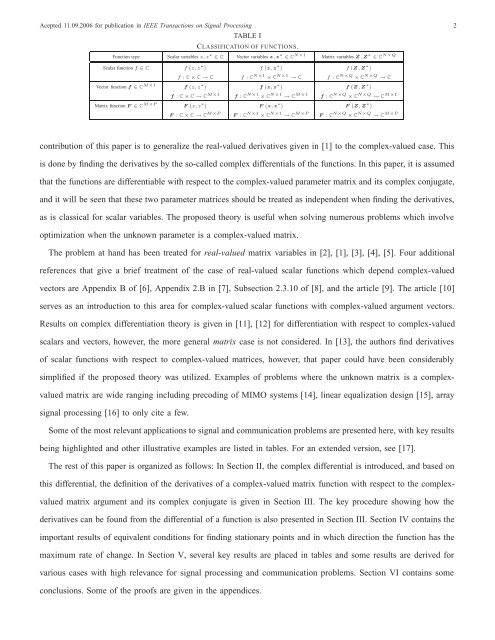Complex-Valued Matrix Differentiation: Techniques and Key ... - Unik
Complex-Valued Matrix Differentiation: Techniques and Key ... - Unik
Complex-Valued Matrix Differentiation: Techniques and Key ... - Unik
You also want an ePaper? Increase the reach of your titles
YUMPU automatically turns print PDFs into web optimized ePapers that Google loves.
Acepted 11.09.2006 for publication in IEEE Transactions on Signal Processing 2TABLE ICLASSIFICATION OF FUNCTIONS.Function type Scalar variables z, z ∗ ∈ C Vector variables z, z ∗ ∈ C N ×1 <strong>Matrix</strong> variables Z, Z ∗ ∈ C N ×QScalar function f ∈ C f ( z, z ∗) f ( z, z ∗) f ( Z , Z ∗)f : C × C → C f : C N ×1 × C N ×1 → C f : C N ×Q × C N ×Q → CVector function f ∈ C M×1 f ( z, z ∗) f ( z, z ∗) f ( Z , Z ∗)f : C × C → C M×1 f : C N ×1 × C N ×1 → C M×1 f : C N ×Q × C N ×Q → C M×1<strong>Matrix</strong> function F ∈ C M×P F ( z, z ∗) F ( z, z ∗) F ( Z , Z ∗)F : C × C → C M×P F : C N ×1 × C N ×1 → C M×P F : C N ×Q × C N ×Q → C M×Pcontribution of this paper is to generalize the real-valued derivatives given in [1] to the complex-valued case. Thisis done by finding the derivatives by the so-called complex differentials of the functions. In this paper, it is assumedthat the functions are differentiable with respect to the complex-valued parameter matrix <strong>and</strong> its complex conjugate,<strong>and</strong> it will be seen that these two parameter matrices should be treated as independent when finding the derivatives,as is classical for scalar variables. The proposed theory is useful when solving numerous problems which involveoptimization when the unknown parameter is a complex-valued matrix.The problem at h<strong>and</strong> has been treated for real-valued matrix variables in [2], [1], [3], [4], [5]. Four additionalreferences that give a brief treatment of the case of real-valued scalar functions which depend complex-valuedvectors are Appendix B of [6], Appendix 2.B in [7], Subsection 2.3.10 of [8], <strong>and</strong> the article [9]. The article [10]serves as an introduction to this area for complex-valued scalar functions with complex-valued argument vectors.Results on complex differentiation theory is given in [11], [12] for differentiation with respect to complex-valuedscalars <strong>and</strong> vectors, however, the more general matrix case is not considered. In [13], the authors find derivativesof scalar functions with respect to complex-valued matrices, however, that paper could have been considerablysimplified if the proposed theory was utilized. Examples of problems where the unknown matrix is a complexvaluedmatrix are wide ranging including precoding of MIMO systems [14], linear equalization design [15], arraysignal processing [16] to only cite a few.Some of the most relevant applications to signal <strong>and</strong> communication problems are presented here, with key resultsbeing highlighted <strong>and</strong> other illustrative examples are listed in tables. For an extended version, see [17].The rest of this paper is organized as follows: In Section II, the complex differential is introduced, <strong>and</strong> based onthis differential, the definition of the derivatives of a complex-valued matrix function with respect to the complexvaluedmatrix argument <strong>and</strong> its complex conjugate is given in Section III. The key procedure showing how thederivatives can be found from the differential of a function is also presented in Section III. Section IV contains theimportant results of equivalent conditions for finding stationary points <strong>and</strong> in which direction the function has themaximum rate of change. In Section V, several key results are placed in tables <strong>and</strong> some results are derived forvarious cases with high relevance for signal processing <strong>and</strong> communication problems. Section VI contains someconclusions. Some of the proofs are given in the appendices.
















